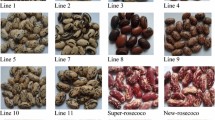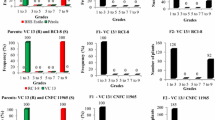Abstract
The deployment of the dominant gene I for the control of bean common mosaic predisposes a bean crop to the risk of death by black root if one or more recessive genes to prevent the hypersensitive plant reaction are lacking. However, during 3 years of observation in Kenya black root occurred only exceptionally to more than 10%, and in such cases the yields from crops having the dominant gene I exceeded significantly those from mosaic-susceptible crops. The use of the dominant resistance factor in Kenya is therefore recommended, but continued caution and monitoring of the disease situation are required. Broadening the resistance basis by adding recessive genes to control black root is advisable.
Samenvatting
Het gebruik van het dominante gen I voor de bestrijding van de virusziekte bonerolmozaïek stelt een bonengewas bloot aan het gevaar van systemische necrose, als niet een of meer recessieve genen aanwezig zijn om deze overgevoeligheidsreactie van de planten te voorkomen. Gedurende een periode van drie jaar werden waarnemingen verricht om na te gaan hoe vaak deze necrose optrad. Slechts bij uitzondering bleek meer dan 10% van de planten te worden aangetast. In die gevallen werd de opbrengst toch aanmerkelijk verhoogd door de aanwezigheid van het dominante gen I. Het gebruik van dit gen ter bestrijding van het bonerolmozaïek wordt daarom voor Kenya aanbevolen. Voortdurend moet echter worden nagegaan in welke mate necrose-inducerende stammen van het virus voorkomen. Een verbreding van de erfelijke basis van de resistentie ter voorkoming van de necrotische reactie door introductie van recessieve resistentiegenen is raadzaam.
Résumé
L'emploi du gène dominant I pour la lutte préventive contre la mosaïque commune du haricot, en I'absence d'un ou plusiers gènes récessifs pour éviter une réaction hypersensible de la plante, entraine un danger de mort de la plante par ‘racines noires’. Néanmoins, pendant les 3 ans d'observations au Kénya, les cas de ‘racines noires’ ne sont apparus qu'exceptionnellement à un taux superieur à 10%, et, dans de tels cas, le rendement du végétal ayant le gène dominant I était, de façon significative, supérieur à celui des végétaux prédisposées à la mosaïque. L'utilisation au Kénya du facteur de résistance dominant est par conséquent recommendé mais une attention et une surveillance permanentes de I'évolution de la maladie sont nécessaires. On peut conseiller I'élargissement de la base de résistance par addition de gènes récessifs pour le contrôle de la maladie des ‘racines noires’.
Similar content being viewed by others
References
Anonymous, 1974. Distribution maps of plant diseases, map no. 213, edition 3, issued 1.X.1974. Commonwealth Mycological Institute, Kew, England.
Anonymous, 1977. Maize production. Crops Advisory Leaflet no. 261, Kenya Ministry of Agriculture.
Anonymous, 1978. Field problems of beans in Latin America. Centro Internacional de Agricultura Tropical, Cali, Colombia, p. 8–9.
Anonymous, 1981. Potential for field beans in Eastern Africa. Proceedings of a regional workshop held in Malawi, Lilongwe from 9–14 March, 1980. CIAT series No. 03 EB-1, Centro Internacional de Agricultura Tropical, Cali, Colombia.
Drijfhout, E., 1978. Genetic interaction betweenPhaseolus vulgaris and bean common mosaic virus with imnplications for strain identification. Centre for Agricultural Publishing and Documentation, Wageningen, the Netherlands, 98 pp.
Grogan, R. G. and Walker, J. C., 1948. The relation of common mosaic to black root of bean. J. agric. Res. (Washington D.C.) 77, 315–331.
Hampton, R. O., 1975. The nature of bean yield reduction by bean yellow and bean common mosaic viruses. Phytopathology 65, 1342–1346.
Hubbeling, N., 1972. Resistance in beans to strains of bean common mosaic virus. Meded. Fac. Landb. wet. Rijksuniv. Gent 37, 458–466.
Hubbeling, N., 1973. Report on bean diseases in Kenya. Cyclostyled paper, Research Institute for Plant Protection, Wageningen, the Netherlands, 27 pp.
Kaiser, W. J., 1976. Important diseases and pests of bean (Phaseolus vulgaris), lima bean (Phaseolus lunatus) and pigeon pea (Cajanus cajan) in Africa. African. J. Pl. Prot. 1, 97–102.
Kulkarni, H.Y., 1973. Notes on East African plant virus diseases.IV. Bean common mosaic virus. E. Afr. agric. For. J. 38, 72–76.
Lind, E. M. & Tallantire, A. C., 1962. Some common flowering plants of Uganda. Oxford University Press, London.
Meiners, J. P., Gillaspie, Jr., A. G., Lawson, R. H. & Smith, F. F., 1978. Identification and partial characterization of a strain of bean common mosaic virus fromRhynchosia minima. Phytopathology 68, 283–287.
Montegro, B. J. & Galindo, A. J., 1974. Bean common mosaic virus in Guanajuato and evaluation of varietal resistance. Agrociencia 18, 89–95; from: Centro Internacional de Agricultura Tropical, Abstracts on Field Beans II, 1978, no. 0647-5642, p. 224; Cali, Colombia.
Mukunya, D. M. & Keya, S. C., 1975.Phaseolus bean production in East Africa. Cyclostyled paper, Nairobi university, pp. 71.
Omunyin, M.E., 1979. Screening for resistance to bean common mosaic virus in food bean (Phaseolus vulgaris L.). Paper presented at the Symposium on Grain Legume Improvement in East Africa, Nairobi 20–24 August, 1979, pp. 8.
Rheenen, H. A. van, 1979. Breeding and Selection Programme, Grain Legume Project. Phase III. Cyclostyled paper, National Horticultural Research Station, Thika, Kenya, pp. 25.
Rheenen, H. A. van, Hasselbach, O. E. & Muigai, S. G. S., 1981. The effect of growing beans together with maize on the incidence of bean diseases and pests. Neth. J. Pl. Path. 87, 193–199.
Schonherr, S. & Mbugua, E. S., 1976. Bean production in Kenya's Central and Eatern Provinces. Occasional Paper No. 23. Institute for Development studies, University of Nairobi.
Schwartz, H. F. & Galvez, G., 1980. Bean production problems CIAT series No. 09 EB-1. Centro Internacional de Agricultura Tropical, Cali, Colombia.
Settler, F. W. & Wilkinson, R. E., 1966. Effect of probing behaviour and starvation ofMyzus persicae on transmission of bean common mosaic virus. Phytopathology 56, 1079–1082.
Siderius, W. & Muchena, F. N., 1977. Soils and environmental conditions of agricultural research stations in Kenya. Miscellaneous Soil Paper, Kenya Soil Survey, No. 5, Nairobi.
Siqueira, O., Caetano, V. Da R., Costa, J. C. Da & Brandes, D., 1971. Presence of the bean common mosaic virus in Rio Grande do Sul and in Santa Catarina. Revista da Sociedade Brasileira de Fitopatologia 4, 69–70; from: Centro Internacional de Agricultural Tropical, Abstracts on Field Beans VIII (1), 1983, no. 0140-15854, p. 59, Cali, Colombia.
Steel, R. G. D. & Torrie, J. W., 1980. Principles and procedures of statistics—A biometrical approach, 2nd ed., McGraw-Hill Kogakusha, Ltd., Tokyo.
Turner, L. K., Budden, F. J. & Knighton, D., 1982., Advanced mathematics. Longman Group Limited, Harlow, Essex, England.
Author information
Authors and Affiliations
Rights and permissions
About this article
Cite this article
Van Rheenen, H.A., Muigai, S.G.S. Control of bean common mosaic by deployment of the dominant gene I. Netherlands Journal of Plant Pathology 90, 85–94 (1984). https://doi.org/10.1007/BF01994513
Accepted:
Issue Date:
DOI: https://doi.org/10.1007/BF01994513




